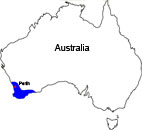Western pygmy perch facts for kids
Quick facts for kids Western pygmy perch |
|
|---|---|
 |
|
| Photo by Jim Owens Male, showing breeding colors |
|
 |
|
| Photo by Jim Owens Female, showing breeding colors |
|
| Conservation status | |
| Scientific classification | |
 |
|
| Beira range | |
| Synonyms | |
|
The western pygmy perch (Nannoperca vittata) is a small fish that lives only in southwestern Australia. When a plant or animal lives only in one place, it is called endemic to that area. This little fish is a type of temperate perch.
Contents
What Does the Western Pygmy Perch Look Like?
The western pygmy perch is a small fish, usually growing up to about 8 centimeters (about 3 inches) long. Its body has a mix of olive, brown, and green colors, often with a mottled, or spotty, pattern. It also has two orange stripes along its sides.
How Do Pygmy Perch Colors Change?
When it's time for them to have babies, the male pygmy perch become much brighter. They get golden spots along their sides and their bellies turn a reddish-orange color. Their fins also become darker. Female pygmy perch change too, developing a bluish color during this special time.
Where Does the Western Pygmy Perch Live?
The western pygmy perch is found only in the rivers and streams along the coast of southwestern Western Australia. Its home stretches from the Waychinicup River in the east, near Albany, all the way up to the Arrowsmith River, which is about 300 kilometers (186 miles) north of Perth. You can find them in most of the rivers in this area, as well as in lakes near the southern coast.
What is the Habitat of the Western Pygmy Perch?
Western pygmy perch mostly live in lakes, streams, and swamps. They can even handle water that is a little bit salty, known as brackish water. These fish love to hide among plants in the shallow parts of the water, especially around the edges. They are also very good at adjusting to different water temperatures, from almost freezing (0°C) up to warm water (25°C).
What Do Western Pygmy Perch Eat?
These fish are mainly carnivores, which means they eat other small creatures. Their diet includes different kinds of insect larvae, like mosquito larvae. They also eat tiny crustaceans such as ostracods and copepods. Sometimes, they might eat a small amount of algae. They are very skilled at catching mosquitoes right off the water's surface!
Life Cycle and Reproduction of the Western Pygmy Perch
Western pygmy perch lay their eggs one by one. A female might lay 12 to 15 eggs over a few hours. During the breeding season, which is from July to November, both male and female fish become much more colorful.
The eggs are very small, about 1.2 millimeters (less than a tenth of an inch). They are a bit sticky, which helps them attach to underwater plants, rocks, or other things in the water. Spawning, or egg-laying, usually happens in the late morning.
The eggs hatch after about three days. The tiny larvae are only about 3 millimeters long and look quite different from the adult fish. For the first few days, they don't even have a mouth! After about 27 to 30 days, they start to look more like a perch. Western pygmy perch become old enough to have their own babies when they are one year old. They can live for up to 5 years.
Uses of the Western Pygmy Perch
Western pygmy perch can be kept safely in a home aquarium, even with other tropical fish. They are also considered safe to be with tadpoles. Because they eat mosquito larvae, they are sometimes used in frog ponds to help control mosquito populations.



